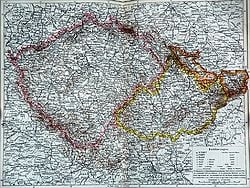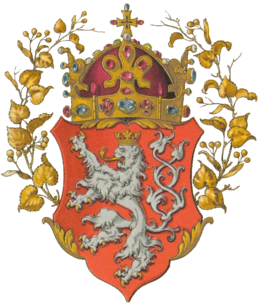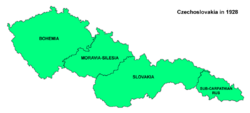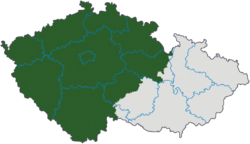Difference between revisions of "Bohemia" - New World Encyclopedia
Mary Anglin (talk | contribs) |
({{Contracted}}) |
||
| Line 1: | Line 1: | ||
| − | {{Claimed}} | + | {{Claimed}}{{Contracted}} |
[[Image:Flag of Bohemia.svg|thumb|250px|right|Flag of Bohemia]] | [[Image:Flag of Bohemia.svg|thumb|250px|right|Flag of Bohemia]] | ||
Revision as of 16:19, 12 February 2007
Bohemia (Czech: Čechy; Template:Audio-de) is a historical region in central Europe, occupying the western and middle thirds of the Czech Republic. It has an area of 52,750 km² and 6.25 million of the country's 10.3 million inhabitants.
Bohemia is bordered by Germany to the southwest, west, and northwest, Poland to the north-east, the Czech historical region of Moravia to the east, and Austria to the south. Bohemia's borders are marked with mountain ranges such as the Šumava, the Ore Mountains, and the Giant Mountains within the Sudeten mountains.
Note: In the Czech language there is no distinction between adjectives referring to Bohemia and the Czech Republic, i.e. český means both Bohemian and Czech.
History
Ancient Bohemia
Roman authors provide the first clear reference to this area as Boiohaemum, Germanic for "the home of the Boii," a Celtic people. As part of the territory often crossed during the Migration Period by major Germanic and Slavic tribes, the area was settled from the 1st century B.C.E. by Germanic (probably Suebic) peoples including the Marcomanni. After their migration to the southwest, they were replaced around the 6th century by the Slavic precursors of today's Czechs.
Přemyslid dynasty
After freeing themselves from the rule of the Avars in the 7th century, Bohemia's Slavic inhabitants came (in the 9th century) under the rule of the Přemyslid dynasty, which continued until 1306. With Bohemia's conversion to Christianity in the 9th century, close relations were forged with the East Frankish kingdom, then part of the so-called Carolingian empire, later the nucleus of the Holy Roman Empire of which Bohemia was an autonomous part from the 10th century.
The first to use the title of "King of Bohemia" was Boleslav I after 940, but his heirs again used the title of duke. The title of king was granted to the Přemyslid dukes Vratislav II (1085) and Vladislav II (1158), and became hereditary (1198) under Ottokar I. His grandson Ottokar II (king from 1253–1278) founded a short-lived empire which covered modern Austria. The mid-13th century saw the beginning of substantial German immigration as the court sought to replace losses from the brief Mongol invasion of Europe in 1241. The Germans settled primarily along the northern, western, and southern borders of Bohemia, although many lived in towns throughout the kingdom.
Luxembourg dynasty
The House of Luxembourg came to the Bohemian throne with the crowning of John I of Bohemia in 1310. Charles IV became King of Bohemia in 1346 and founded Charles University in Prague, central Europe's first university, two years later. His reign brought Bohemia to its peak both politically and in total area, resulting in his being the first King of Bohemia to be elected as Holy Roman Emperor. Under his rule the Bohemian crown controlled such diverse lands as Moravia, Silesia, Upper Lusatia and Lower Lusatia, Brandenburg, an area around Nuremberg called New Bohemia, Luxembourg, and several small towns scattered around Germany.
Hussite Bohemia
During the ecunemical Council of Constance in 1415, Jan Hus, the rector of Charles University and a prominent reformer and religious thinker, was sentenced to be burnt at the stake as a heretic. The verdict was passed despite the fact that Hus was granted formal protection by Emperor Sigismund of Luxemburg prior to the journey. Hus was invited to attend the council to defend himself and the Czech positions in the religious court, but with the emperor's approval, he was executed on July 6 1415. The execution of Hus, as well as a papal crusade against heretics like the Hussites and John Wycliffe, outraged the Czechs. Their ensuing rebellion against Romanists became known as the Hussite Wars.
The largely peasant uprising against imperial forces was led by a former mercenary, Jan Žižka of Trocnov. As the leader of the Hussite armies, he utilized innovative tactics and weapons, such as howitzers, pistols (from Czech píšťala, the flute), and fortified wagons, which were revolutionary for the time and established Žižka as a great general.
After Žižka's death, Prokop the Great took over the command for the army, and under his lead the Hussites were victorious for another ten years, to the sheer terror of Europe. The Hussite cause gradually splintered into two main factions, the moderate Utraquists and the more fanatic Taborites. After the Utraquists reunited with the Catholic Church, they were able to defeat the Taborites in the Battle of Lipany in 1434. Sigismund said after the battle that "only the Bohemians could defeat the Bohemians."
Despite the victory, the Bohemian Utraquists were still in the position to negotiate freedom of religion in 1436. This happened in the so-called Basel Compacts, declaring peace and freedom between Catholics and Utraquists. It would only last for a short period of time, as Pope Pius II declared the Basel Compacts to be invalid in 1462.
In 1458, George of Podebrady was elected to ascend to the Bohemian throne. He is remembered for his attempt to set up a pan-European "Christian League", which would form all the states of Europe into a community based on religion. In the process of negotiating, he appointed Leo of Rozmital to tour the European courts and to conduct the talks. However, the negotiations were not completed because George's position was substantially damaged over time by his deteriorating relationship with the Pope.
Habsburg Monarchy
After the death of King Louis II of Hungary and Bohemia in the Battle of Mohács in 1526, Archduke Ferdinand of Austria became King of Bohemia and the country became a constituent state of the Habsburg Monarchy.
Bohemia enjoyed religious freedom between 1436 and 1620, and became one of the most liberal countries of the Christian world during that period of time. In 1609 King Rudolph II, himself a Roman Catholic, was moved by the Bohemian nobility to publish Maiestas Rudolphina, which confirmed the older Confessio Bohemica of 1575.
After King Ferdinand II began oppressing the rights of Protestants in Bohemia, the resulting Czech rebellion resulted in the outbreak of the Thirty Years' War in 1618. Elector Frederick V of the Palatinate, a Protestant, was elected by the Bohemian nobility to replace Ferdinand on the Bohemian throne. However, after Frederick's defeat in the Battle of White Mountain in 1620, a few Protestant noblemen were executed and the rest were exiled from the country; their lands were then given to Catholic loyalists.
Until the so-called "renewed constitution" of 1627, the German language was established as a second official language in the Czech lands. The Czech language remained the first language in the kingdom. Both German and Latin were widely spoken among the ruling classes, although German became increasingly dominant, while Czech was spoken in much of the countryside.
The formal independence of Bohemia was further jeopardized when the Bohemian Diet approved administrative reform in 1749. It included the indivisibility of the Habsburg Empire and the centralization of rule; this essentially meant the merging of the Royal Bohemian Chancellery with the Austrian Chancellery.
At the end of the 18th century, the Czech national revivalist movement, in cooperation with part of the Bohemian aristocracy, started a campaign for restoration of the kingdom's historic rights, whereby the Czech language was to replace German as the language of administration. The enlightened absolutism of Joseph II and Leopold II, who introduced minor language concessions, showed promise for the Czech movement, but many of these reforms were later rescinded. During the Revolution of 1848, many Czech nationalists called for autonomy for Bohemia from Habsburg Austria, but the revolutionaries were defeated. The old Bohemian Diet, one of the last remnants of the independence, was dissolved, although the Czech language experienced a rebirth as romantic nationalism developed among the Czechs.
In 1861, a new elected Bohemian Diet was established. The renewal of the old Bohemian Crown (Kingdom of Bohemia, Margraviate of Moravia, and Duchy of Silesia) became the official political program of both Czech liberal politicians and the majority of Bohemian aristocracy ("state rights program"), while parties representing the German minority and small part of the aristocracy proclaimed their loyalty to the centralistic Constitution (so-called "Verfassungstreue"). After the defeat of Austria in the Austro-Prussian War in 1866, Hungarian politicians achieved the Ausgleich (compromise) which created Austria-Hungary in 1867, ostensibly creating equality between the Austrian and Hungarian halves of the empire. An attempt of the Czechs to create a tripartite monarchy (Austria-Hungary-Bohemia) failed in 1871. However, the "state rights program" remained the official platform of all Czech political parties (except for social democrats) until 1918.
20th century
After World War I, Bohemia became the core of the newly-formed country of Czechoslovakia, which combined Bohemia, Moravia, Austrian Silesia, and the Northern parts (Highlands) of Hungary into one state. Under its first president, Tomáš Masaryk, Czechoslovakia became a rich and liberal democratic republic.
Following the Munich Agreement in 1938, the border regions of Bohemia inhabited predominantly by ethnic Germans (the Sudetenland) were annexed to Nazi Germany; this was the single time in Bohemian history that its territory was divided. The remnants of Bohemia and Moravia were then annexed by Germany in 1939, while the Slovak lands became Slovakia. From 1939–1945 Bohemia (without the Sudetenland) formed with Moravia the German Protectorate of Bohemia and Moravia (Reichsprotektorat Böhmen und Mähren). After World War II ended in 1945, the vast majority of remaining Germans were expelled through the Beneš decrees.
Beginning in 1949, Bohemia ceased to be an administrative unit of Czechoslovakia, as the country was divided into kraje. In 1989 Agnes of Bohemia became the first saint from a Central European country to be canonized by Pope John Paul II before the "Velvet Revolution" later that year. After the dissolution of Czechoslovakia in 1993 (the "Velvet Divorce"), the territory of Bohemia became part of the new Czech Republic.
The Czech constitution from 1992 refers to the "citizens of the Czech Republic in Bohemia, Moravia and Silesia" and proclaims continuity with the statehood of the Bohemian Crown. Bohemia is not currently an administrative unit of the Czech Republic. Instead, it is divided into the Prague, Central Bohemian, Plzeň, Karlovy Vary, Ústí nad Labem, Liberec, and Hradec Králové Regions, as well as parts of the Pardubice, Vysočina, South Bohemian and South Moravian Regions.
See also
- History of Bohemia
- History of the Czech lands
- List of rulers of Bohemia
- Sudetenland
- German Bohemia
- Bohemia
Template:HRE electors
| ||||||||||||
Footnotes
Sources and Further Reading
- Sayer,Derek , The coasts of Bohemia: a Czech history, Princeton, N.J., Princeton University Press, 1998, ISBN 0691057605 - ISBN 9780691057606
- Freeling,Nicolas , The Seacoast of Bohemia, New York, Mysterious Press, 1995, ISBN 089296555X - ISBN 9780892965557 OCLC: 31754195
- Teich, Mikuláš, Bohemia in History, Cambridge, U.K.; New York, NY, Cambridge University Press, 1998, ISBN 0521431557 OCLC: 37211187
- Oman, Carola, The Winter Queen: Elizabeth of Bohemia, London; Phoenix, 2000, ISBN 1842120573 OCLC: 43879234
External Links
Credits
New World Encyclopedia writers and editors rewrote and completed the Wikipedia article in accordance with New World Encyclopedia standards. This article abides by terms of the Creative Commons CC-by-sa 3.0 License (CC-by-sa), which may be used and disseminated with proper attribution. Credit is due under the terms of this license that can reference both the New World Encyclopedia contributors and the selfless volunteer contributors of the Wikimedia Foundation. To cite this article click here for a list of acceptable citing formats.The history of earlier contributions by wikipedians is accessible to researchers here:
The history of this article since it was imported to New World Encyclopedia:
Note: Some restrictions may apply to use of individual images which are separately licensed.





